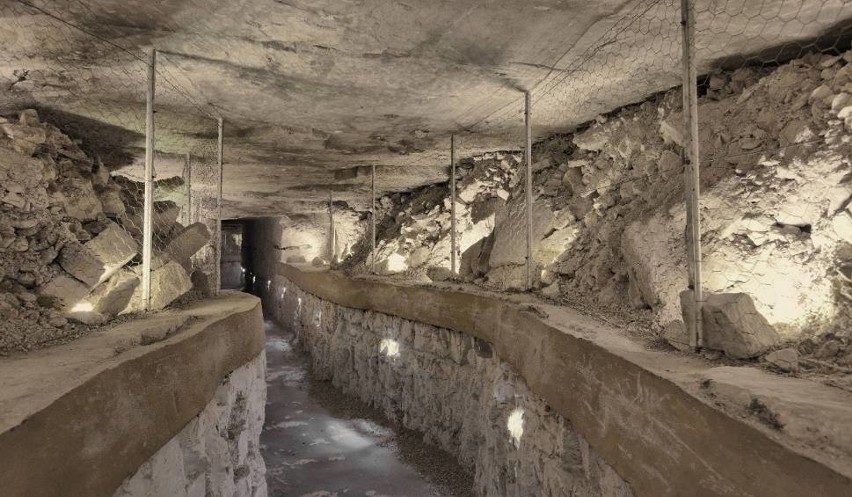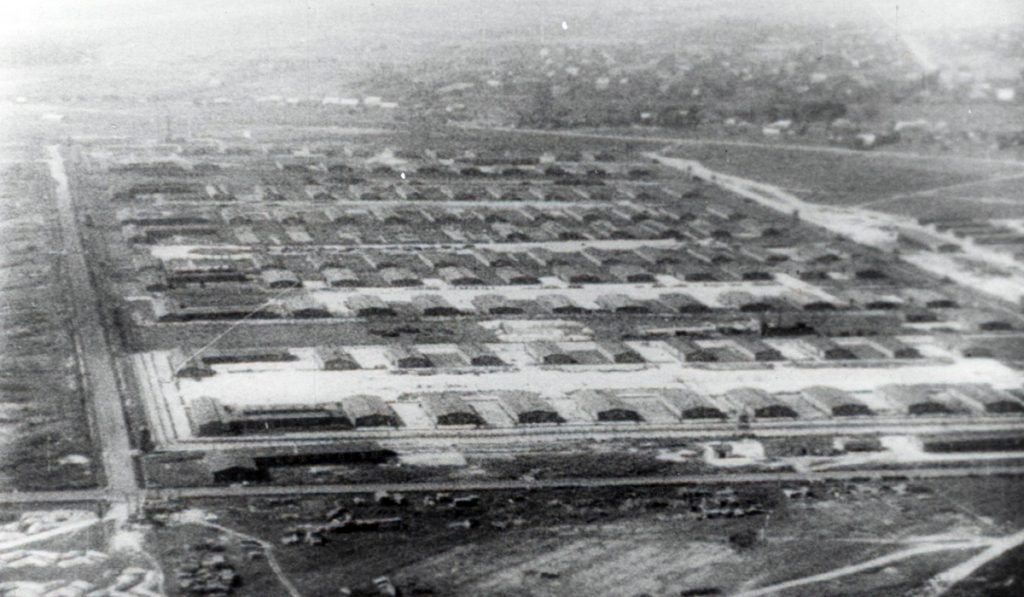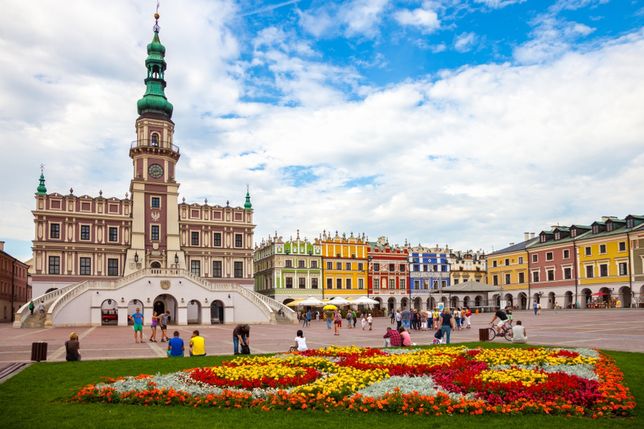Poland – Lublin, Świętokrzyskie (Kielce) August 14, 2019
KIELCE (pop 196,000)
This city in south central Poland has been the capital city of the Świętokrzyskie Voivodeship (Holy Cross Province) since 1999. The city is located in the middle of the Świętokrzyskie Mountains (Holy Cross Mountains), on the banks of the Silnica River, in northern part of the historical Polish province of Lesser Poland.
The history of Kielce dates back over 900 years and the exact date when the town was founded remains unknown. The name of the city derives from the migrating Celts, who once stopped here during their journey across the European continent. The area was later inhabited at the beginning of the 11th century by hunters and beekeepers, who bartered the fruit of their work for seed grain. It was then that a marketplace was established, where forest products were exchanged for agricultural produce. At the turn of the 12th century, the bishops of Kraków became the owners of the settlement and began constructing a castle on a nearby hill. In the 13th century, Tatar raids on Poland destroyed the city completely, but it was soon rebuilt and surrounded by a high defensive wall, equipped with firing slots for archers.
Between 1637-42, a Renaissance palace was erected, which survived to the present day and remains an icon. The city was burned to the ground during the Swedish Deluge in the 17th century. After the Partitions of Poland, Kielce became part of the Austrian Empire. During World War II, Kielce was the site of German Nazi atrocities and executions carried out on the Jewish population in the ghetto. After the war the city saw a massacre of the Jews that had survived the Nazi death camps. One of those murdered was a three-week-old baby. They had returned, hoping to rebuild their lives.which later became known as the Kielce pogrom.
Kielce was once an important centre of limestone mining and has natural resources like copper, lead and iron, which, over the centuries, were exploited on a large scale. The city and its surroundings are also known for their historic architecture, green spaces and recreational areas such as the Świętokrzyski National Park.
Ostrowlec Swictokrzski. A NM “European City”, it has an old town on a low rise with pedestrianized streets. The flint mines are 8km northeast.
Krzemionki. Listed as World Heritage Site (2019), these prehistoric striped flint mines functioned for most of the Neolithic Age and at the beginning of the Bronze Age (3900-1600 BC). The preserved architecture of the underground cavities have survived almost unchanged creating a great monument of Prehistoric mining techniques. Discovered in 1922, it covers an area of 78.5ha with a width of 20-200m and length of 4.5kms. There are about 4,000 mines of four types that differ by their depth and excavation system. The largest and most complex cavities are 9m deep, a few hundred m2 and 55-120cm high. The miners used simple stone and horn tools to mine the flint which was then taken to a workshop where it was divided into smaller parts and tools formed. The striped flint axes produced here were distributed throughout Central Europe.
First see the museum (without one word of English) that has an ethnographic display of locals, some local art and exhibits of flint. Then go on a tour (no English guide was available when I was there) to see the Neolithic mines, mine tips and shafts. Go on a 2km route past a reconstructed Neolithic village, two mines with roofs – a prehistoric pit with niches and a shaft, then descend a spiral stairs down to walk through about 500m of 6m X 1m tunnels constructed through the white limestone about 15 years ago. The tunnel follows the layer of flint that was actively mined. Pass two kinds of underground mines: pillar mines (a shaft was sunk and the area at the bottom was mined) and chamber mines (a shaft was sunk and then the layers of flint followed with side tunnels varying from,5m to 1.2m high. These opened up into large chambers where the concentration of flint was hghes. The roof was supported by columns of unmined limestone. The constructed tunnel has many pieces of flint projecting and lining it. The mined areas are usually small tunnels filled with rubble. PLN 16, 12 reduced


The other large sources of flint in Europe were: Grimes Graves and Cissberry in Great Britain, St Michel and Grand Pransigny in France, Spiennes in Belgium, Rijckholt in Netherland, Hov in Denmark, Langfeld in Austria, Tata in Hungary and Ros in Belarus.
Flint is a hard, sedimentary cryptocrystalline form of the mineral quartz, categorized as the variety of chert that occurs in chalk or marly limestone. Flint was widely used historically to make stone tools and start fires.
It occurs chiefly as nodules and masses in sedimentary rocks, such as chalks and limestones. Inside the nodule, flint is usually dark grey, black, green, white or brown in colour, and often has a glassy or waxy appearance. A thin layer on the outside of the nodules is usually different in colour, typically white and rough in texture. The nodules can often be found along streams and beaches.
Flint breaks and chips into sharp edged pieces, making it useful for knife blades and other cutting tools. The use of flint to make stone tools dates back millions of years, and flint’s extreme durability has made it possible to accurately date its use over this time. Flint is one of the primary materials used to define the Stone Age.
During the Stone Age, access to flint was so important for survival that people would travel or trade to obtain flint. Flint Ridge in Ohio was an important source of flint and Native Americans extracted the flint from hundreds of quarries along the ridge. This “Ohio Flint” was traded across the eastern United States and has been found as far west as the Rocky Mountains and south around the Gulf of Mexico.
When struck against steel, flint will produce enough sparks to ignite a fire with the correct tinder, or gunpowder used in weapons. Although it has been superseded in these uses by different processes (the percussion cap), or materials, (ferrocerium), “flint” has lent its name as generic term for a fire starter.
LUBLIN (pop 340,000)
The 9th largest city in Poland, it is 170kms SE of Warsaw.
History. It was a centre of trade and commerce on the Vilnius – Krakow road and played an important role in the formation of the Lithuanian-Polish Commonwealth, the Reformation and a large Jewish community from the 16th century. In 1931, 60% or the population were Catholic and 34% Jewish. Its picturesque, historical old town survived WW II preserved. The main university and largest employer is the University of Maria Curie-Sklodowska.
Lublin Ghetto. Created in 1941 with 34,000 Jews, 26,000 (especially the elderly, disabled, ill or unable to work) were sent to Belzec in April/May 1942, a death camp for extermination. 7,000 healthy people went to Maldanek. Most of the rest were shot in the ghetto.
Muzeum Wsi Lubelskiej (Lublin Open-Air Musuem). Created in 1970, and covering 60 acres, it has a wide range of buildings: 16 farmsteads, 7 houses and cottages, a manor house, 17th century RC and an 18th century Greek Catholic churches plus one bell tower, crafts (smithies, wheelwright, lapidarium), town buildings (town hall, school, fire hall, jail), wells, oil presses, 4 roadside shrines, and a windmill all relocated from the Lublin area. Many traditional items are displayed. PLN 12. 6 reduced
University of Maria Curie-Sklodowska Botanic Garden.
Lublin Castle Museum. A castle with a wood bulwark was built in the 12th century followed by a Romanesque donjon and defensive tower in the 13th. In the 14th, a brick castle surrounded by ramparts and a Gothic castle church were built. It was dedicated to the Holy Trinity and served as a royal chapel. The church’s interior was cover by Rus-Byzantine wall paintings completed in 1418 that remain today.
The castle was important as it was on the royal route from Cracow to Vilnius. In 1520, the castle was reconstructed into a royal residence using Italian masters. Parliament held sessions here in 1569. In the wars of the 17th century it became a ruin and only the oldest sections, the chapel and donjon remained intact. From 1824-26, a new neo-Gothic building was built and served as a jail fro 128 years. From 1831-1915, it housed Polish insurgents and from 1918-39, communists were jailed for taking action against the Polish state. In WWII, the Nazis used it as a prison and 40,000 inmates went through, many dying in executions and sent to death camps. When they left on July 22, 1944, 300 prisoners were executed. The Russians also used it as a harsh jail and secret police building with 35,000 Poles jailed and 1000 death sentences. After 1954, the castle was reconstructed and has been the Lublin Museum.
The castle was being completely renovated and only a small room by the ticket desk and the donjon are open. Each floor of the donjon has exhibits: 1st – 1944-54 as a Communist prison, 2nd prison medieval to 1944, 3rd and 4th art and on top the open deck with great views of Lublin, the main reason to come. No English. PLN 10, 6 reduced
Holy Trinity Chapel. See the history above. The 1418 wall murals remain today – natural pigments were initially applied on wet plaster producing very durable paintings. In 1820, the walls were completely plastered, From 1917-23, attempts were made to remove the plaster and reconstruct the fragments completely damaged. More was done in the 1950s but damage from humidity continued the damage. Air conditioners were installed and over 20 years from 1976-1995, they were recovered completely. The murals cover the entire interior including the large central column in this small chapel. The ribs on the ceiling all have nice geometric designs and the arches floral motifs. There are no pews and lots of tourists. It is entered as part of the Castle Museum. 
St. John the Baptist Cathedral. Founded in the late 1500s, this 3-nave church has a baroque interior that is quite magnificent with faux marble columns, ornate gilt capitals and murals covering the ceilings, walls and all the chapels. The altar is black and covered with gilt columns, statues and angels. All the painting frames, open confessionals and pulpit are similarly adorned with gilt.

Majdanek Concentration Camp (The State Museum of Majdanek). Majdanek was built in 1941 and operated until 1944 to house Soviet prisoners, Jews from Lubin and farmers who did not supply food or Poles who were in the resistance. Original plans were room for 150,000 but eventually only 40,000 “spaces” were built. On entering the camp everyone had the ritual shower and disinfection, then were shaven. Gas chambers operated from Sept 42-Sept 43 using carbon monoxide from tanks and when closed, all the sonderkommando (the people who emptied the gas chambers and thus witnesses) were shot. In November 1943, 18,000 Jews were shot in one day. Prisoners came from all over – the Czechoslovakia, Belarus, Ukraine and even as far away as Paris and Belgium, then Jews from Warsaw and Blastock.
It was a labour camp and being unable to work, illness or going to the hospital meant death. If there was no work, senseless work like carrying stones for long distances was meted out. Bad health, fleas, lice and starvation was rampant. 150,000 passed through the camp and 80,000 died here. Bodies were dealt with in a crematorium and the ashes spread on fields.
80 buildings from the camp still exist, covering an area of about ⅓ of the original camp. A double row barbed wire fence surrounding the entire camp, guard towers and a few other buildings are reconstructions. There are exhibits in several of the barracks especially the previous warehouses outside the barbed wire. Many personal vignettes tell the stories of several of the inmates. 25 barracks remain within the barbed wire. The rest are visible as foundations. There is also a large mausoleum and the remnants of the crematorium. The monument is a confusing large rough stone block with many holes on 2 small pillars.
Pay for parking (the only fee – PLN 5 for a car) and walk or drive around the large site.


ZAMOSC (pop 65,000)
90kms south of Lublin.
Old City of Zamość was added to the World Heritage list in 1992 as a unique Renaissance town built in accordance with Italian theories of an ideal town with fragments of a fortress (rebuilt to restore the city’s appearance) and several houses around the great square.
Great Market Square – 100m X 100m, one of the most beautiful 16th century squares in Europe surround by a complex of brightly coloured, arcaded houses embellished with white stucco carvings: red Under the Angel House (carved Archangel Gabriel holding a lily and the second floor decorated with lions and a dragon), the yellow Under the Madonna House (polychrome Madonna and baby Jesus standing on a dragon), Under St Casmir House, green Wilczek House (Baroque with St John the Baptist and St Thomas with 3 spears), blue Under the Married Couple House (grotesque figures of a married couple on the parapet). 
 Town Hall built at the turn of the 16th and 17th centuries and had 3-stories added, a double curving stairs and a dome with a lantern.
Town Hall built at the turn of the 16th and 17th centuries and had 3-stories added, a double curving stairs and a dome with a lantern.
Zamoski Palace at its head. Salt Square and Water Square add to the design.
Cathedral (1587-1598), 45m long and 30m wide with many side chapels, thin pillars and fine vaulted presbytery, grey stone ribs, capitals and arches, crypts of 17 families. Has a separate baroque bell tower with 3 – 1700s bells. I entered at service with many present all older than me.
Zamojskie Museum. In the red Under the Angle House, its highlights are many bronze sculptures and wood beamed ceilings. Also military cannon and uniforms, traditional costumes, crafts with a loom, art and a scale model of the town. PLN10, 6 reduced
NOMAD MANIA Poland – Lublin, Świętokrzyskie (Kielce)
World Heritage Sites
“Krzemionki”, prehistoric flint mines
Old City of Zamość
Borders
Belarus-Poland
Poland-Ukraine
Villages and Small Towns
Kazimierz Dolny
Sandomierz
Castles, Palaces, Forts: Ujazd: Krzyżtopór Castle
Religious Temples:
Koden: Our Lady of Koden
Starachowice: Wąchock Abbey
World of Nature: Roztocze
Aquariums: Zagnansk: Oceanika
Windmills: Tokarnia: Countryside Museum Mills (Marked Skansen Tokarnia)
Caves: Paradise Cave (Jaskinia Raj)
European Cities
CHELM
OSTROWLEC SWICTOKRZYSKI
KIELCE
Museums
Kielce: Museum of Toys and Play
Kielce: The National Museum in Kielce
LUBLIN
Airports: Lublin (LUZ)
Museums: Muzeum Wsi Lubelskiej
Castles, Palaces, Forts: Lublin Castle Museum
Religious Temples:
St. John the Baptist Cathedral
Holy Trinity Chapel, Lublin (Sight)
Botanical Gardens: Lublin: University of Maria Curie-Sklodowska Botanic Garden
The Dark Side: Majdanek Concentration Camp (The State Museum of Majdanek)
ZAMOSC
World Heritage Sites: Old City of Zamość
Museums: The Zamojskie Museum
